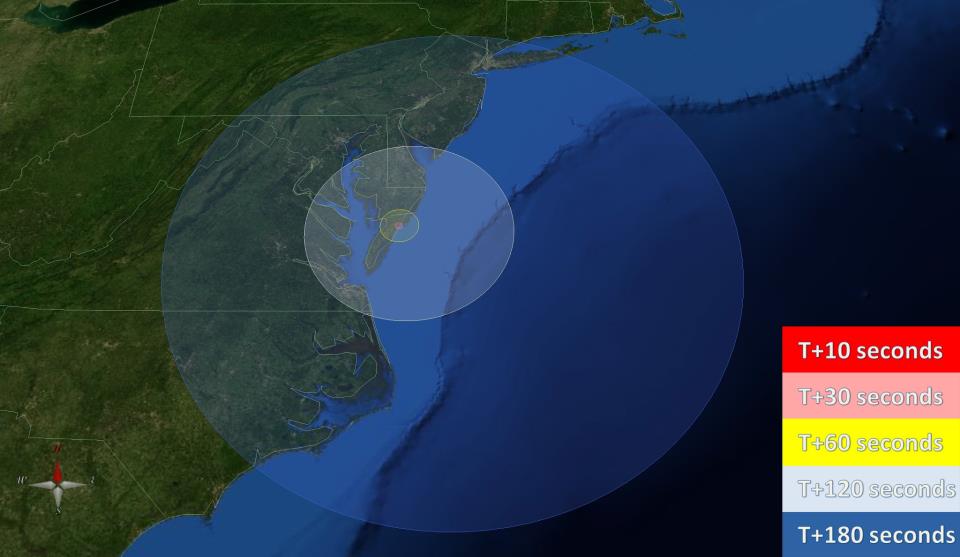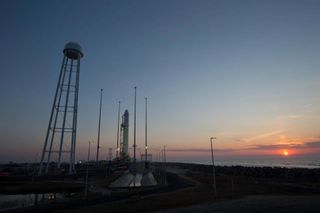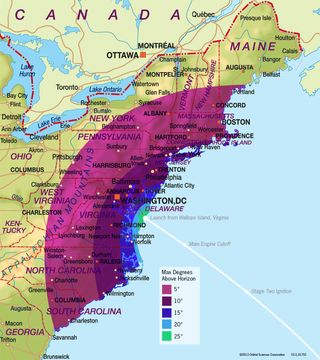New Private Rocket Launching from Virginia Coast Wednesday: Watch It Live

WALLOPS ISLAND, Va. — An untested commercial rocket is poised to launch into space from Virginia's Eastern Shore on Wednesday (April 17), and you can watch the test flight live online.
The new private Antares rocket, built by the Dulles-based Orbital Sciences Corp., is slated to blast off from NASA's Wallops Flight Facility at the southern tip of this small island at 5 p.m. EDT (2100 GMT). If all goes well, the test flight will pave the way for the future unmanned cargo deliveries to the International Space Station.
NASA will broadcast the launch live on NASA TV beginning at 4 p.m. EDT (2000 GMT) on Wednesday. You can watch the Antares rocket launch webcast on SPACE.com, courtesy of NASA. Visibility maps released by the Wallops facility and Orbital officials suggest that the rocket could be seen from as far north as Portland, Maine, and as far south as Charleston, S.C., weather permitting. [Photos: Private Antares rocket poised for launch]

"The best chance to see the flight extends from about Cape May, NJ southward through the Outer Banks of North Carolina," Orbital officials explained in an update. "Also, if you happen to be in Bermuda, you will likely have a clear view of Antares as it rockets by."
More than 100 reporters are expected to descend upon the NASA Wallops visitor's center on Wednesday, as well as a huge crowd of launch fans, center officials said. More onlookers are advised to watch the launch from the nearby Assateague Beach, NASA Wallops spokesman Keith Koehler told SPACE.com.
"It's going to be a bright light in the sky," Koehler said.
The rocket will lift off from Pad 0A at the Mid-Atlantic Regional Spaceport, a commercial spaceport at the Wallops Flight Facility. The Wallops facility, established in 1945, is NASA's lead center for small suborbital rocket launches and balloon science missions.
Get the Space.com Newsletter
Breaking space news, the latest updates on rocket launches, skywatching events and more!

The two-stage Antares rocket is designed to launch Orbital's cylindrical unmanned cargo ship, called Cygnus, on at least eight delivery flights to the International Space Station under a $1.9 billion deal with NASA. Orbital is one of two companies with a NASA contract for space station cargo deliveries. The other is Space Exploration Technologies (SpaceX) of Hawthorne, Calif., which has launched one test flight and two cargo delivery missions to the station since 2012 under a separate $1.6 billion contract.
For Orbital Sciences, Wednesday's launch is the first major flight test for the Antares rocket. The two-stage rocket is 131 feet (40 meters) tall and about 12.7 feet (3.9 m) wide and will launch toward the southeast out over the Atlantic Ocean during the 10-minute flight.
The upcoming Antares test flight will not carry a Cygnus spacecraft. Instead, it will carry a mock payload, called a "mass simulator," to mimic a Cygnus vehicle, including three tiny satellites for NASA and one commercial nanosatellite.
Orbital engineers replaced a faulty valve on the Antares rocket after it halted an engine test on Saturday (April 13). With the fix in place, Orbital officials and NASA are now tracking the weather for Wednesday's test.
"There is a 45 percent chance of favorable weather at the time of launch," NASA officials said in a statement late Monday (April 15). "Low clouds are the primary concern for a weather violation."
Visit SPACE.com for complete coverage of Wednesday's Antares rocket test flight.
Editor's note: If you snap a great photo of Orbital's Antares rocket launch that you'd like to share for a possible story or image gallery, send photos, comments and your name and location to managing editor Tariq Malik at spacephotos@space.com.
Join our Space Forums to keep talking space on the latest missions, night sky and more! And if you have a news tip, correction or comment, let us know at: community@space.com.

Tariq is the Editor-in-Chief of Space.com and joined the team in 2001, first as an intern and staff writer, and later as an editor. He covers human spaceflight, exploration and space science, as well as skywatching and entertainment. He became Space.com's Managing Editor in 2009 and Editor-in-Chief in 2019. Before joining Space.com, Tariq was a staff reporter for The Los Angeles Times covering education and city beats in La Habra, Fullerton and Huntington Beach. In October 2022, Tariq received the Harry Kolcum Award for excellence in space reporting from the National Space Club Florida Committee. He is also an Eagle Scout (yes, he has the Space Exploration merit badge) and went to Space Camp four times as a kid and a fifth time as an adult. He has journalism degrees from the University of Southern California and New York University. You can find Tariq at Space.com and as the co-host to the This Week In Space podcast with space historian Rod Pyle on the TWiT network. To see his latest project, you can follow Tariq on Twitter @tariqjmalik.